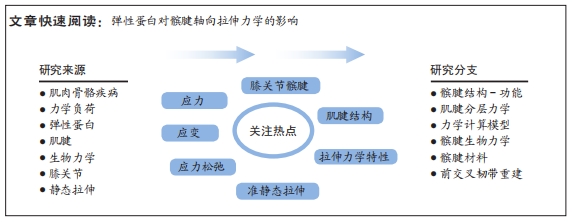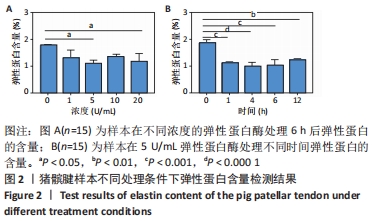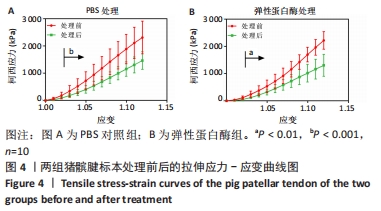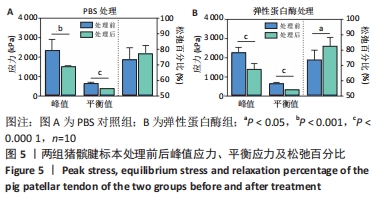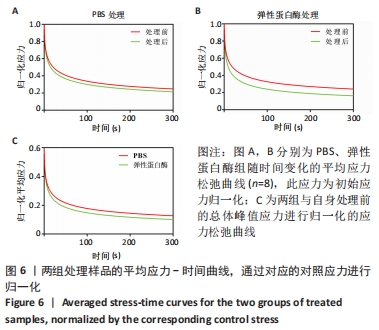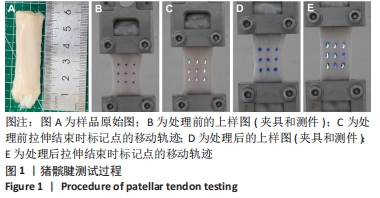[1] HUTCHISON MK, HOUCK J, CUDDEFORD T, et al. Prevalence of Patellar Tendinopathy and Patellar Tendon Abnormality in Male Collegiate Basketball Players: A Cross-Sectional Study. J Athl Train. 2019;54(9):953-958.
[2] BREDA SJ, OEI E, ZWERVER J, et al. Effectiveness of progressive tendon-loading exercise therapy in patients with patellar tendinopathy: a randomised clinical trial. Br J Sports Med. 2021;55(9):501-509.
[3] BURTON I. Interventions for prevention and in-season management of patellar tendinopathy in athletes: A scoping review. Phys Ther Sport. 2022;55:80-89.
[4] FIRMINGER CR, EDWARDS WB. Effects of cyclic loading on the mechanical properties and failure of human patellar tendon. J Biomech. 2021;120:110345.
[5] FIRMINGER CR, EDWARDS WB. A biomechanical study of clamping technique on patellar tendon surface strain and material properties using digital image correlation. J Mech Behav Biomed Mater. 2021;113:104156.
[6] GOLMAN M, WRIGHT ML, WONG TT, et al. Rethinking Patellar Tendinopathy and Partial Patellar Tendon Tears: A Novel Classification System. Am J Sports Med. 2020;48(2):359-369.
[7] RUMIAN AP, DRAPER ER, WALLACE AL, et al. The influence of the mechanical environment on remodelling of the patellar tendon. J Bone Joint Surg Br. 2009; 91(4):557-564.
[8] ZHANG C, COUPPÉ C, SCHEIJEN J, et al. Regional collagen turnover and composition of the human patellar tendon. J Appl Physiol (1985). 2020;128(4): 884-891.
[9] HELLAND C, BOJSEN-MØLLER J, RAASTAD T, et al. Mechanical properties of the patellar tendon in elite volleyball players with and without patellar tendinopathy. Br J Sports Med. 2013;47(13):862-868.
[10] 陈一言, 陆阿明, 齐亚楠, 等. 大强度跳跃负荷下p38MAPK对兔髌腱起止点微细结构影响[J]. 体育科研,2021,42(6):86-92.
[11] TORNIAINEN J, RISTANIEMI A, SARIN JK, et al. Near infrared spectroscopic evaluation of biochemical and crimp properties of knee joint ligaments and patellar tendon. PLoS One. 2022;17(2):e263280.
[12] RISTANIEMI A, TORNIAINEN J, STENROTH L, et al. Comparison of water, hydroxyproline, uronic acid and elastin contents of bovine knee ligaments and patellar tendon and their relationships with biomechanical properties. J Mech Behav Biomed Mater. 2020;104: 103639.
[13] DE MOUDT S, LELOUP A, FRANSEN P. Aortic Stiffness Hysteresis in Isolated Mouse Aortic Segments Is Intensified by Contractile Stimuli, Attenuated by Age, and Reversed by Elastin Degradation. Front Physiol. 2021;12:723972.
[14] UGRADAR S, KARLIN J, LE A, et al. Photochemical Collagen Cross-Linking Reverses Elastase-Induced Mechanical Degradation of Upper Eyelid Tarsus. Ophthalmic Plast Reconstr Surg. 2020;36(6):562-565.
[15] HILL JR, EEKHOFF JD, BROPHY RH, et al. Elastic fibers in orthopedics: Form and function in tendons and ligaments, clinical implications, and future directions. J Orthop Res. 2020;38(11):2305-2317.
[16] GRANT TM, YAPP C, CHEN Q, et al. The Mechanical, Structural, and Compositional Changes of Tendon Exposed to Elastase. Ann Biomed Eng. 2015;43(10):2477-2486.
[17] HENNINGER HB, UNDERWOOD CJ, ROMNEY SJ, et al. Effect of elastin digestion on the quasi-static tensile response of medial collateral ligament. J Orthop Res. 2013;31(8):1226-1233.
[18] AKINTUNDE A, ROBISON KM, CAPONE D, et al. Effects of elastase digestion on the murine vaginal wall biaxial mechanical response. J Biomech Eng. 2018;141(2): 210111-2101111.
[19] LEVILLAIN A, ORHANT M, TURQUIER F, et al. Contribution of collagen and elastin fibers to the mechanical behavior of an abdominal connective tissue. J Mech Behav Biomed Mater. 2016;61:308-317.
[20] YANG F, DAS D, CHASIOTIS I. Strain rate induced toughening of individual collagen fibrils. Appl Phys Lett. 2022;120(11):114101.
[21] KIM DK, AHN J, KIM SA, et al. Improved Healing of Rabbit Patellar Tendon Defects After an Atelocollagen Injection. Am J Sports Med. 2021;49(11):2924-2932.
[22] SVENSSON RB, ERIKSEN CS, TRAN P, et al. Mechanical properties of human patellar tendon collagen fibrils. An exploratory study of aging and sex. J Mech Behav Biomed Mater. 2021;124:104864.
[23] LIU Y, BALLARINI R, EPPELL SJ. Tension tests on mammalian collagen fibrils. Interface Focus. 2016;6(1):20150080.
[24] BLOOM ET, LEE AH, ELLIOTT DM. Tendon Multiscale Structure, Mechanics, and Damage Are Affected by Osmolarity of Bath Solution. Ann Biomed Eng. 2021; 49(3):1058-1068.
[25] LEE AH, ELLIOTT DM. Freezing does not alter multiscale tendon mechanics and damage mechanisms in tension. Ann N Y Acad Sci. 2017;1409(1):85-94.
[26] FANG F, LAKE SP. Multiscale mechanical integrity of human supraspinatus tendon in shear after elastin depletion. J Mech Behav Biomed Mater. 2016;63:443-455.
[27] 胡凯, 陈维明, 骆井万, 等. 过氧乙酸/乙醇对异体皮性能的影响[J]. 中国组织工程研究,2022,26(10):1537-1543.
[28] DUENWALD SE, VANDERBY RJ, LAKES RS. Viscoelastic relaxation and recovery of tendon. Ann Biomed Eng. 2009;37(6):1131-1140.
[29] LEE AH, SZCZESNY SE, SANTARE MH, et al. Investigating mechanisms of tendon damage by measuring multi-scale recovery following tensile loading. Acta Biomater. 2017;57:363-372.
[30] LAKE SP, MILLER KS, ELLIOTT DM, et al. Effect of fiber distribution and realignment on the nonlinear and inhomogeneous mechanical properties of human supraspinatus tendon under longitudinal tensile loading. J Orthop Res. 2009;27(12):1596-1602.
[31] 黄涛, 刘晓云, 邓羽平, 等. 实时动态拉伸下成人肱二头肌、肱三头肌的生物力学特性[J]. 中国组织工程研究,2022,26(12):1828-1833.
[32] CASTILE RM, SKELLEY NW, BABAEI B, et al. Microstructural properties and mechanics vary between bundles of the human anterior cruciate ligament during stress-relaxation. J Biomech. 2016,49(1):87-93.
[33] HIRANO E, KNUTSEN RH, SUGITANI H, et al. Functional rescue of elastin insufficiency in mice by the human elastin gene: implications for mouse models of human disease. Circ Res. 2007;101(5):523-531.
[34] KIM SH, MONTICONE RE, MCGRAW KR, et al. Age-associated proinflammatory elastic fiber remodeling in large arteries. Mech Ageing Dev. 2021;196:111490.
[35] HENNINGER HB, VALDEZ WR, SCOTT SA, et al. Elastin governs the mechanical response of medial collateral ligament under shear and transverse tensile loading. Acta Biomater. 2015;25:304-312.
[36] GODINHO MS, THORPE CT, GREENWALD SE, et al. Elastase treatment of tendon specifically impacts the mechanical properties of the interfascicular matrix. Acta Biomater. 2021;123:187-196.
[37] JACOBS NT, SMITH LJ, HAN WM, et al. Effect of orientation and targeted extracellular matrix degradation on the shear mechanical properties of the annulus fibrosus. J Mech Behav Biomed Mater. 2011;4(8):1611-1619.
[38] FAZAELI S, MIRAHMADI F, EVERTS V, et al. Alteration of structural and mechanical properties of the temporomandibular joint disc following elastase digestion. J Biomed Mater Res B Appl Biomater. 2020;108(8):3228-3240.
[39] EEKHOFF JD, ABRAHAM JA, SCHOTT HR, et al. Fascicular elastin within tendon contributes to the magnitude and modulus gradient of the elastic stress response across tendon type and species. Acta Biomater. 2022;S1742-7061(22)00156-8.
[40] PATEL D, ZAMBOULIS DE, SPIESZ EM, et al. Structure-function specialisation of the interfascicular matrix in the human achilles tendon. Acta Biomater. 2021;131: 381-390.
[41] HILL JR, EEKHOFF JD, BROPHY RH, et al. Elastic fibers in orthopedics: Form and function in tendons and ligaments, clinical implications, and future directions.J Orthop Res. 2020;38(11):2305-2317.
[42] CHAUDHURI O, COOPER-WHITE J, JANMEY PA, et al. Effects of extracellular matrix viscoelasticity on cellular behaviour. Nature. 2020;584(7822):535-546.
[43] ROSS CJ, LAURENCE DW, ECHOLS AL, et al. Effects of enzyme-based removal of collagen and elastin constituents on the biaxial mechanical responses of porcine atrioventricular heart valve anterior leaflets. Acta Biomater. 2021;135:425-440.
[44] EEKHOFF JD, STEENBOCK H, BERKE IM, et al. Dysregulated assembly of elastic fibers in fibulin-5 knockout mice results in a tendon-specific increase in elastic modulus. J Mech Behav Biomed Mater. 2021;113:104134.
|
